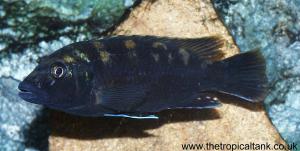
This fish has not yet been assigned a species name.
Scientific name: Melanochromis sp. "Blotch"
Size: 4-5" (10-12.5cm)
Origin: Lake Malawi, East Africa
Tank setup: A large tank with many rock caves
Compatibility: Combine with other mbuna species
Temperature: 23-28oC (73-82oF)
Water chemistry: Hard and alkaline: pH 7.6-8.6 ; GH 7 ; KH 10-12
Feeding: Carnivorous: feed live, frozen and flake foods.
Breeding: Mouthbrooder, see general article linked below.
 +
+

